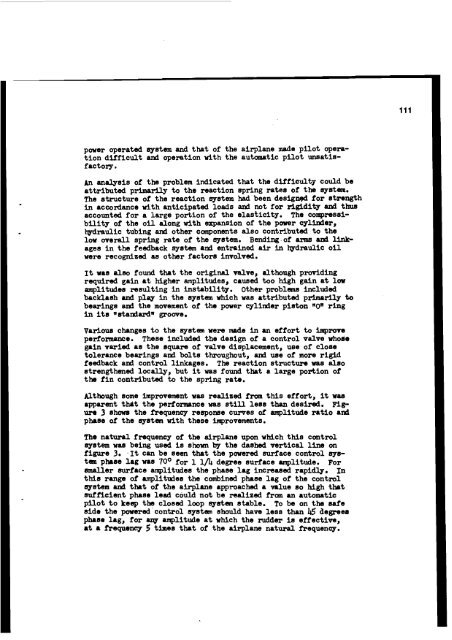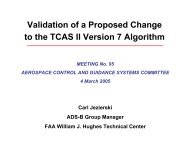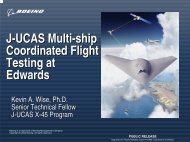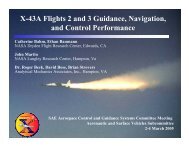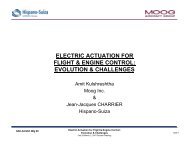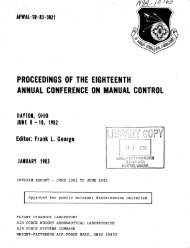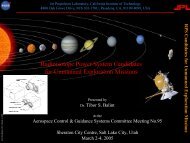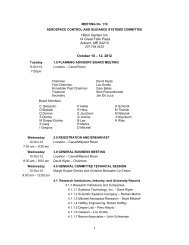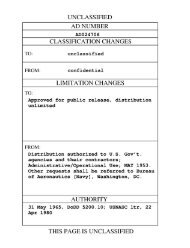Report of the Second Piloted Aircraft Flight Control System - Acgsc.org
Report of the Second Piloted Aircraft Flight Control System - Acgsc.org
Report of the Second Piloted Aircraft Flight Control System - Acgsc.org
You also want an ePaper? Increase the reach of your titles
YUMPU automatically turns print PDFs into web optimized ePapers that Google loves.
power operated syetem and that <strong>of</strong> <strong>the</strong> airplane made pilot operation<br />
difficult and operation with <strong>the</strong> automatic pilot unsatiefactoxy.<br />
An analyeis <strong>of</strong> <strong>the</strong> problem indicated that <strong>the</strong> difficulty could be<br />
attributed primarily to <strong>the</strong> reaction epring rates <strong>of</strong> <strong>the</strong> sgsten.<br />
The structure <strong>of</strong> <strong>the</strong> reaction vetem had been deaignqd for strength<br />
in accordance wlth anticipated loads and not for rigidity and thus<br />
accounted for a large portion <strong>of</strong> <strong>the</strong> elasticity. The compressibility<br />
<strong>of</strong> <strong>the</strong> oil along with mansion <strong>of</strong> <strong>the</strong> power cylinder,<br />
I~~Iraulic tubing ard o<strong>the</strong>r components also contributed to <strong>the</strong><br />
low overall spring rate <strong>of</strong> <strong>the</strong> qstem. Bending <strong>of</strong> a m and linkage8<br />
in <strong>the</strong> feedback system ad entrained air in hydraulic oil<br />
were recognised as o<strong>the</strong>r factors involved.<br />
1t was also found that <strong>the</strong> original ralw, although providing<br />
required gain at higher amplitudes, caused too high gain at low<br />
amplitudes resulting in instability. O<strong>the</strong>r probleuw included<br />
backlaeh uxl play in <strong>the</strong> system which was attributed primarily to<br />
bearings and <strong>the</strong> movenent <strong>of</strong> <strong>the</strong> power cylillder piston "0" ring<br />
In its Nstardardm groove.<br />
Various changes to <strong>the</strong> syetem were made in an effort to improve<br />
performance. These included <strong>the</strong> design <strong>of</strong> a control valve whose<br />
gain varied as <strong>the</strong> square <strong>of</strong> valve displacement, use <strong>of</strong> close<br />
tolerance bearings ad bolte throughout, and use <strong>of</strong> more rigid<br />
feedback ad control linkages. The reaction structure was also<br />
etreng<strong>the</strong>ned locally, but it was found that a large portion <strong>of</strong><br />
<strong>the</strong> fin contributed to <strong>the</strong> spring rate.<br />
Althaugh some improvement was realited from this effort, it was<br />
apparent tMt <strong>the</strong> performance was still less than desired. Figura<br />
3 shows <strong>the</strong> frequency response curves <strong>of</strong> amplitude ratio ad<br />
phaee <strong>of</strong> <strong>the</strong> sgstem with <strong>the</strong>se inprovements.<br />
The natural frequency <strong>of</strong> <strong>the</strong> airplane upon which this control<br />
system was being used is shown by <strong>the</strong> dashed vertical line on<br />
figure 3. .It can be eeen that <strong>the</strong> pawered surface control eyetam<br />
phse lag wae 70° for 11/4 degree eurface amplitude. For<br />
smaller surface amplitude8 <strong>the</strong> phase lag increased rapidly. In<br />
this rmga <strong>of</strong> unplitndes <strong>the</strong> combined phaee lag <strong>of</strong> <strong>the</strong> control<br />
syetsm and tht <strong>of</strong> <strong>the</strong> airplane approached a value so high that<br />
mfflcient phaee lead could not be realised from m automatic<br />
pilot to keep <strong>the</strong> closed loop sgstem stable.<br />
To be on <strong>the</strong> safe<br />
side <strong>the</strong> powered control system should ham less than kS degrees<br />
phase lag, for q amplitude at which <strong>the</strong> rudder is effectiw,<br />
at a frequency 5 times that <strong>of</strong> <strong>the</strong> airplane natural frequency.


